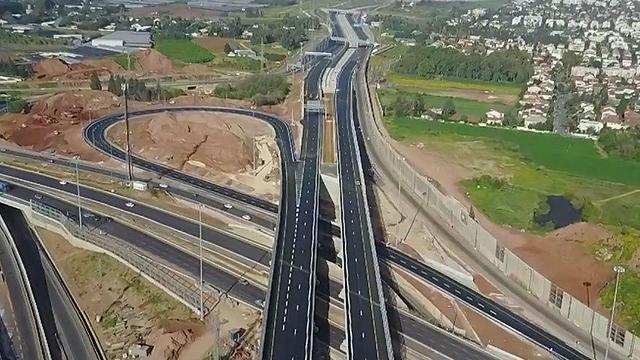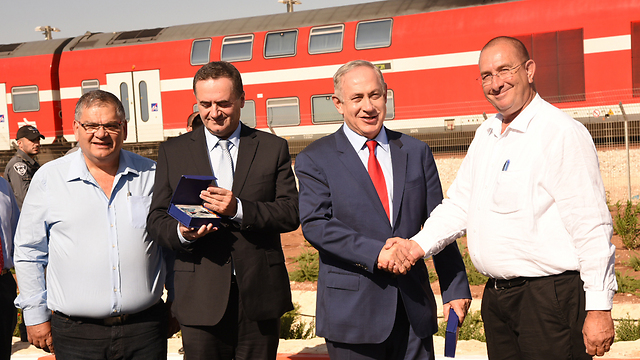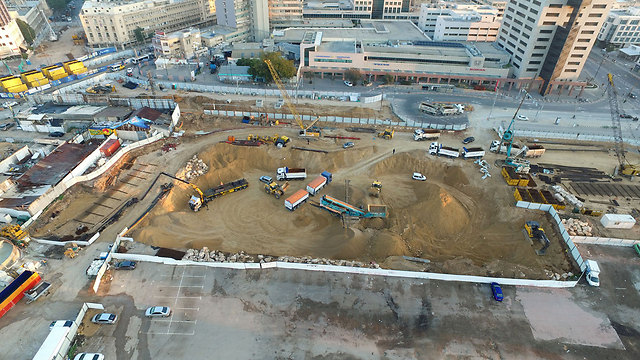

Gov't unveils infrastructure investment super-program
After mapping out the country's entire current infrastructure projects, a program meant to draw foreign and private capital to infrastructure investments will be implemented; Ministry of Transportation leads with field with 63 projects of the 147 on the list.
A multiyear program, the first of its kind, will be presented to the cabinet Sunday that would combine the development of all 147 infrastructure projects planned in Israel for 2017-2021 to the tune of NIS 116 billion ($32 billion).
The program was drafted after the government reached a decision in August of last year to map out all national infrastructural projects in transportation, education, welfare, environmental protection, agriculture, energy and more.
This newly drafted list contains every infrastructure project in Israel according to the following criteria: its cost is estimated to be more than NIS 100 million, its economic feasibility was examined, and a governmental decision or budgetary arrangement is in place to finance it.
"We're continuing the infrastructure investment and construction upswing all across Israel," Prime Minister Benjamin Netanyahu said. "We'll continue bringing the periphery closer to the center for the benefit of all Israelis and build more roads, interchanges and train tracks."
"This program will allow the government to provide Israel's citizens with better service in transportation, energy, health and many other fields," he added.
"Mapping the project is a crucial first step in raising foreign investment in infrastructure, in increasing those investments and in developing the Israeli economy," noted Director-General of the Prime Minister's Office, Eli Groner.
"The program was put together in light of insights stemming from meetings we held with international investment bodies that consider Israel a preferred destination for investment in infrastructure," Groner said. "Making the program known to the public is yet another component in integrating effective organizational culture relating to planning and monitoring to the civil service. Transparency in the government's main areas of activity further leverages improving it."
Bank of Governor Karnit Flug told the ministers that improving public transport infrastructure would be one area of investment.
"The level of infrastructure in Israel is insufficient, particularly in the area of public transportation, and mainly in the major cities, but also in the electricity delivery system and in communication infrastructure," Flug said.
"The volume of annual investment is low by international comparison, and we are therefore not closing the gap in the level of infrastructure compared to other advanced economies, which weighs down productivity and the growth potential of the economy."
Flug said the government should set up a special unit to specialize in the management and monitoring of public-private partnership (PPP) tenders and contracts.
"It is important that an informed estimation of the costs be made, and that the budgetary sources be defined, in order to avoid stopping projects and sharp cutbacks in projects as has happened in the past at times of budgetary stress," she said.
Large investment in transportation
Most of the projects the list showcases are in transportation—63 of the 147 total projects—with 51% of the construction costs coming from the light rail projects in Tel Aviv, Jerusalem and Haifa, 22% from building new roads, 15% from building train tracks, 5% from creating new public transport lanes, an additional 3% for high-capacity urban public-transit system, 1% for bike lanes and more.
The light rail's forthcoming green line, for instance—set to connect Rishon Lezion, Tel Aviv and Herzliya—will encompass a public-private partnership: the line's lower structure will be publically funded whereas the uppermost structure will be operated as a public-private partnership through franchising to private firms.
The same goes for the purple line between Ramat Gan and Tel Aviv and the green line in Jerusalem connecting the Gilo neighborhood with the Government Quarter.
Similar methods will be utilized to obtain funding for high-speed lanes planned on Highway 20 and Highway 2, expected to open 2025, and on Highway 16, expected to open a year prior.
In energy, 61% of construction costs go to projects in power, 14% to water-conduction systems, 12% to gas infrastructures, 11% to sewage conduction and 2% to fuel and LPG (liquefied petroleum gas) projects.
Examined according to the Ministry of Interior's division to districts, 31% of infrastructure investment in the program will go to projects in the central district, 27% to Tel Aviv projects, 17% to the northern district, 10% to the southern, 9% to Jerusalem, 5% to Haifa and 1% to the West Bank.

The next cabinet meeting will also discuss a decision to appoint an overseeing team to accompany the project, set to include Groner, the accountant general and the director of budgets. This team will monitor the projects' implementation and expand their suitability to implementation and financing through the private sector. The team will also work to improve the structure of tenders and to increase infrastructure transparency to the government, public and investors alike.
The main principle behind the program and its many attendant details is constructing new managerial methods to invest in Israeli infrastructure. To that end, for instance, each ministry will have to examine whether a prospective infrastructure investment project is suitable for foreign or other outer-governmental investment.
A rather stunning statistic shows only 6% of infrastructural projects in Israel bring the private sector into the fold, while foreign investment funds are yearning to invest in Israel. Another added effect of outsourcing certain financing to the private sector is that the government is not bound by budgetary constraints when it does so.
This new method will make it far easier for the state to put together funding for infrastructure projects, say sources within the Prime Minister's Office, to spread them over more years and to get better prices for them. "This will instill uniform management in all government ministries," the sources said. "It will change the government's DNA. We're trying to communicate to the ministries they can think big."
"We're forcing ministries to be more effective and use their purchasing power," said another PMO official. "They shouldn't think small about the next year or two or work with small contractors to build a few missing daycare centers. Instead, put together a list of all the daycare centers you need around the country and let's build hundreds of them at once. Let's invite huge multinational companies to build them. Same goes for classrooms."
The program's infrastructure mapping will be made public every six months. The Prime Minister's Office is hoping the next batch of plans will go from NIS 116 billion to 500 billion, and within a year or two reach the first trillion.


















